“Ah, the splendor of that Sunday night dance. The flames beat and curled against the moonlit sky. The church bells chimed. The scorched and crooked thing, self-wounded and chained to his cot, crawled to the edge of the ash with a stifled groan, but the brave and sturdy farmers pricked him back with the bloody pitchforks until the deed was done. Let the eagle scream! Civilization is again safe.”1
—W.E.B. Du Bois
THIS VERSE—INTENTIONALLY SARCASTIC AND GRIM—appeared in the September 1911 issue of the NAACP publication The Crisis and was penned by its editor W.E.B. Du Bois, one of the towering intellectual figures of the twentieth century. Du Bois was the first African American PhD from Harvard University, the architect of Pan-Africanism, and a founding member of both the Niagara Movement and the NAACP. He was a historian, a sociologist, a poet, and an artist (the director of the pageant The Star of Ethiopia).2 He was the author of numerous books, including The Souls of Black Folk and Black Reconstruction in America. He was also served as editor of The Crisis for nearly a quarter of a century (1910–1934), a position that allowed him to reach a vast audience and a position where he advocated on behalf of numerous social causes, including the campaign against lynching. His primary weapons against this crime: words, emotional appeals, statistics, and visual images.
![]()
The horrific crime of lynching in the United States was aimed at upholding white supremacy during the Jim Crow era, particularly in the Deep South.3 African Americans outnumbered whites in many rural communities, yet occupied the lowest rung of the agricultural labor force as sharecroppers, a position that allowed white wealthy planters to prosper.4 Southern Democrats and plantation owners successfully convinced a large percentage of the white working class to view the black working class as the primary threat to their economic well-being. Laws were enacted that legalized segregation. Laws prevented interracial marriage. Voting rights for African Americans were suppressed. And worst of all, African American men were demonized as rapists—a threat to white women. This climate of race hatred led to race terrorism, exemplified by the proliferation of lynch mobs that threatened African Americans, as well as Jews, gay people, immigrants, Catholics, labor organizers, and radicals. The Tuskegee Institute estimated that 4,742 people were lynched in the United States between 1882 and 1968. Of these victims, 3,445 were black.5 African Americans were lynched for any suspected “crime”—from the serious (murder or rape) to the benign (petty theft or even the failure to step aside for a white man on a sidewalk). Even protesting the lynching of a family member could lead to death. Local law enforcement turned a blind eye or participated in the lynchings.
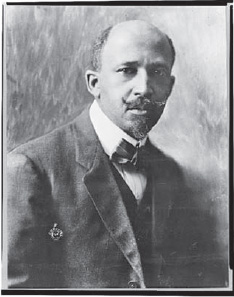
W.E.B. (William Edward Burghardt) Du Bois, ca. May 31, 1919 (LC-USZ62-16767, Library of Congress)
Du Bois sought to change this.6 Two incidents during his first teaching appointment at Atlanta University had shaken him to his core. One was the 1899 lynching of an illiterate sharecropper, Sam Hose, who was accused of killing his landlord and raping the man’s wife. Others professed his innocence, and said that he defended himself during a violent argument with his landlord over wages. Nonetheless, the white community assumed his guilt and sent out a lynch mob. Hose was tortured, castrated, and killed before a massive crowd of white spectators, estimated at more than 4,000 people. Hose’s liver and heart were cooked and pieces were sold for ten cents. Bones were sold for a quarter. His knuckles were then put on display at the local grocery store as a warning sign to all African Americans that they could be next.
The other incident took place in Atlanta proper. It erupted on September 22, 1906, when an estimated 10,000 whites roamed the city beating and killing every African American they could find, including children. The mob was responding to reports in the Evening News about a series of suspected rapes of white women by black men. Du Bois had been away when trouble first erupted, and rushed home to safeguard his wife and daughter. The terror lasted for several days in which Du Bois and his family could hear the screams and gunshots from their home. He later wrote, “I bought a Winchester double barreled shotgun and two dozen rounds of shells filled with buckshot. If a white mob had stepped on campus where I lived I would without hesitation have sprayed their guts over the grass. They did not come.”7 His summary: “One could not be a calm, cool, and detached scientist while Negros were lynched, murdered, and starved.”8
![]()
W.E.B. Du Bois and staff in The Crisis magazine office, no date recorded (Schomburg Center for Research in Black Culture, New York Public Library)
In 1910, Du Bois left Atlanta for New York City and a job firmly rooted outside academia. He became the director of publicity and research for the NAACP and the editor of its monthly publication The Crisis.
Du Bois viewed The Crisis as a platform where he could debate the key issues of the day and engage his audience—primarily the black middle class—with controversial ideas and calls for action. His writings were opinionated and personal, and he rejected the calls for The Crisis to be a space simply to recite the NAACP meeting notes. “From first to last I thought strongly, and I still think rightly, to make the opinion expressed in The Crisis a personal opinion; because as I argued, no organization can express definite and clear-cut opinions.”9 His readers by and large absorbed his editorial stance. The first issue of The Crisis (November 1910) quickly sold out its 1,000-copy print run.
By July 1911, the print run was boosted to 15,000 copies. By November 1915, it was 35,000 copies, and by 1919, circulation reached its peak at just under 100,000.10 Interest in the publication drove interest in the NAACP. By 1919, the NAACP had 300 branches throughout the United States, including 155 branches in the South. Its membership totaled 88,448.11
In the first issue of The Crisis, Du Bois wrote that the publication would set forth “those facts and arguments which show the danger of race prejudice.”12 Not surprisingly, Du Bois addressed lynching in the premiere issue—the murder of two naturalized Italian immigrants in Florida. “The inalienable right of every free American citizen to be lynched without tiresome investigation and penalties,” wrote Du Bois in his patented sarcastic tone, “is one which families of the lately deceased doubtless deeply appreciate.”13
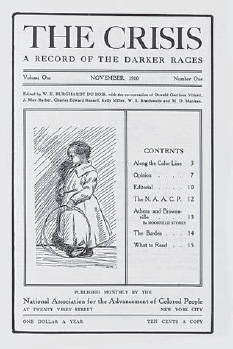
The Crisis, November 1910, front cover illustration assumed to have been drawn by W.E.B. Du Bois (digital ID# na0026, Library of Congress)
The early issues of The Crisis also set the tenor of Du Bois’s editorial slants and biases. Du Bois had an elitist view on how to agitate for change. He believed that change should be led from the top. In 1903, he stated that the Negro race
is going to be saved by its exceptional men . . . Can the masses of the Negro people be in any way more quickly raised than by the effort and example of this aristocracy of talent and character? Has there ever a nation on God’s fair earth civilized from the bottom upward? Never; it is, ever was and ever will be from the top downward that culture filters.14
Du Bois believed that the “talented tenth” should lead the race and educate the other 90 percent. His choice of images in The Crisis visualized his bias. The pages of the magazine were packed with images of successful African American businessmen, college graduates, happy families, and signs of affluence, including photographs of luxurious middle-class homes. He also included photographs of weddings, graduation ceremonies, and baby pictures—all of which asserted a message of racial uplift and his own Victorian sensibilities that spoke to a well-educated class of people. His motives: combat racism and show African Americans as exceptional, as equals, and as positive contributors to the society at large.
Visualizing the Lynching Industry
Du Bois’s photographs of the “ best and the brightest” were harshly juxtaposed next to horrific images of African Americans being lynched. Throughout the pages of The Crisis, Du Bois published accounts of lynchings—charts, maps, eyewitness accounts, drawings, and photographs—and he did so for decades, making The Crisis the most widely circulated publication to continuously combat lynching.
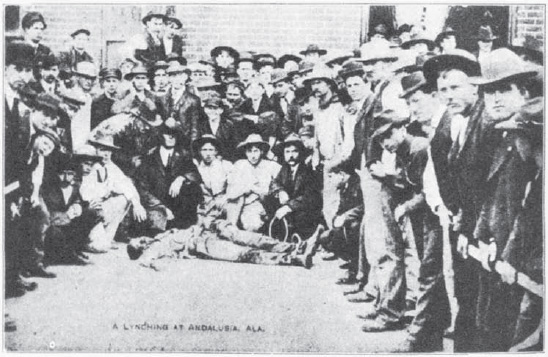
“A Reply to Mr. Holmes from Alabama,” reprinted from The Crisis, January 1912 (University of Wisconsin–Milwaukee Libraries)
One example was the January 1912 issue that featured a postcard that Du Bois reappropriated from its original intent. Entitled “A Reply to Mr. Holmes from Alabama,” the postcard featured a photograph on the front of a lynch mob, faces uncovered, looking straight into the camera lens.
In the center, on the ground, lay the victim. Around him stood the crowd, one with the lynching rope still in hand. The back of the postcard was addressed to Rev. John H. Holmes, a pastor at the Unitarian Church in New York City, a founding member of the NAACP, and an outspoken critic of lynching. The typed message read:
This is the way we do them down here. The last lynching has not been put on card yet. Will put you on our regular mailing list. Expect one a month on average.
The postcard had originally been sent to Holmes as a means of intimidation. In the aftermath of a lynching, photographers would print cards on site and sell copies to the crowd, which often numbered in the thousands. This trade became so widespread that in 1908, the U.S. Postmaster General forbade lynching postcards from being mailed, forcing the cards to go underground, or to be covered by an envelope.
The NAACP defined lynching as community sanctioned murders, and the Holmes postcard embodied this point. By reprinting the ghastly image, Du Bois reappropriated the souvenir postcard, redefined who the criminals were, and provided more visual evidence in the NAACP’s anti-lynching crusade. Du Bois wrote that lynching images were “a gruesome thing to publish, and yet—could the tale have been told otherwise? Can the nation otherwise awaken to the enormity of this beastly crime of crimes, this rape of law and decency?”15
“Awaken” was the key word. Images of lynchings were not widespread in either the mainstream press or the black press before Du Bois made it a focal point in nearly every issue of The Crisis. Daisy Lampkin, a field secretary of the NAACP, noted, “We were so ashamed that whites could do that to us, that we hardly wanted to talk about it publicly.”16 Du Bois’s response was the polar opposite. He was determined to publicize the crime of lynching until the evil practice was wiped off the earth. Du Bois wrote, “We place frankly our greatest reliance in publicity. We propose to let the facts concerning lynching to be known. Today, they are not fully known; they are partially suppressed; they are lied about and twisted. . . . We propose, then, first of all, to let the people of the United States, and the world, know WHAT is taking place. Then we shall try to convict lynchers in the courts.”17
Readers of The Crisis had to force themselves to think beyond the initial shock of the gruesome images. They had to move past horror, shame, and grief in order to move toward anger and collective action. In practical terms, Du Bois’s methods were designed to provoke a reluctant federal government to protect the lives of all of its citizens.
“Lynching in the United States has resolved itself into a problem of saving black America’s body and white America’s soul.”
—James Weldon Johnson, NAACP director18
In July 1916, Du Bois published a special supplementary issue to The Crisis called “The Waco Horror.” It was in response to the May 15 lynching of Jesse Washington—a seventeen-year-old mentally handicapped teenager who was killed in front of a crowd of 15,000 at City Hall Square in Waco, Texas. Du Bois had sent the white journalist Elisabeth Freeman to Waco to investigate the murder. For ten days she gathered information, eyewitness accounts, and souvenir postcards that served as photographic evidence. Freeman’s eight-page supplement to The Crisis was designed to transport the reader to the scene of the sadistic crime.
Washington had confessed to killing Mrs. Fryar, a white woman whom he worked for. He was later charged with raping her, despite no evidence that a sexual crime had taken place. A jury found him guilty after deliberating for four minutes. After the verdict was read, a packed courtroom of 1,500 people surged toward Washington. The judge and the sheriff slipped away, and the mob dragged Washington outside to the awaiting crowd of 15,000. There, Washington was brutally murdered. He was castrated. His ears and fingers were cut off. The crowd repeatedly stabbed him and struck him with shovels, bricks, and clubs. Next he was hanged from a tree by a chain in City Hall Square, right under the mayor’s window, and lowered repeatedly into a fire while still alive. Once dead, the crowd cut up his body, distributed various parts as souvenirs, and finally his torso was dragged through the streets behind a horse.
“The Waco Horror” contained seven images of the lynching of Washington that Freeman had purchased from F.A. Gildersleeve while in Waco, including four gruesome photographs of Washington’s charred body chained to a tree. The images shocked some members of the NAACP board, but Du Bois was unapologetic about printing them. The nation had to confront this type of brutality.
Du Bois arranged the photographs of “The Waco Horror” in chronological order, depicting a college town that had turned uncivilized due to its race hatred. The first three pages included photographs of important building in Waco—campus shots of Baylor University, City Hall, and the courthouse. This segued to scenes of the lynch mob, and then the killing itself.
Most shocking were the images of the lynching by the local white photographer, F.A. Gildersleeve, who had been instructed where to set up his camera before the murder had transpired. Gildersleeve was allied with the mob. His motive was to profit from the murder by selling photographs of the lynching, a practice that was derailed by the city government. Freeman quoted him as saying, “We have quit selling the mob photos, this step was taken because our ‘City dads’ objected on the grounds of ‘bad publicity,’ as we wanted to be boosters and not knockers, we agreed to stop all sale.”19 Gildersleeve’s comments and his images condoned the actions of the mob and served to further terrorize the black community. However, The Crisis was able to subvert the photographs from their original intent when they were recontextualized in the “Waco Horror” exposé.
![Fred A. Gildersleeve, “[Large crowd looking at the burned body of Jesse Washington, seventeen-year-old African American, lynched in Waco, Texas, May 15, 1916]” (LC-USZC4-4647, Library of Congress)](images/f0128-01.jpg)
Fred A. Gildersleeve, “[Large crowd looking at the burned body of Jesse Washington, seventeen-year-old African American, lynched in Waco, Texas, May 15, 1916]” (LC-USZC4-4647, Library of Congress)
Du Bois had the supplementary issue distributed to all members of Congress; he sent copies to more than seven hundred newspapers—including fifty black newspapers—as well as to prominent figures in the arts and politics. Additionally, it reached the 42,000 subscribers of The Crisis. The subsequent public outcry led to congressional consideration of the Dyer Bill in 1919 and 1921. The bill defined lynching as the murder of a U.S. citizen by a mob of three or more. It stated that sheriffs who failed to prevent a lynching were liable for felony charges, fines, and prison sentences. It also stated that the federal government could prosecute lynchers if states refused to, and counties were required to pay fines to the victim’s family ranging from $1,000 to $10,000. The Dyer Bill passed the House, but a filibuster defeated it in the Senate. Southern senators argued, among other things, that lynching was necessary to protect Southern women.20
“The Waco Horror” represented a ramping-up of efforts by Du Bois and the NAACP. It also represented the continued use of graphic text and images to describe a lynching. Amy Helene Kirschke writes, “Du Bois believed that a photograph and a brief editorial were no longer enough. His readers needed to know every detail of lynchings and to know the victim, too, through photographs of the body from several vantage points.”21
Du Bois’s writings and editorial choices served as a call to action. He concluded the text of the supplementary issue with a paragraph that read: “This is an account of one lynching. It is horrible, but it is matched in horror by scores of others in the last thirty years, and in its illegal, law-defying, race-hating aspect, it is matched by 2,842 other lynchings which have taken place between January 1, 1885, and June 1, 1916 . . . What are we going to do about this record? The civilization of America is at stake.”22 His plea ended with “Let every one read this and act.”23
Silent Parades, Flag Memorials, and Boycotts
Du Bois’s use of visual materials on behalf of activism took many other forms as well. Some were rooted in the streets. Du Bois and James Weldon Johnson organized a large-scale demonstration following the East St. Louis massacre—a race riot in May and July of 1917 that left six thousand African Americans homeless and more than one hundred dead.24
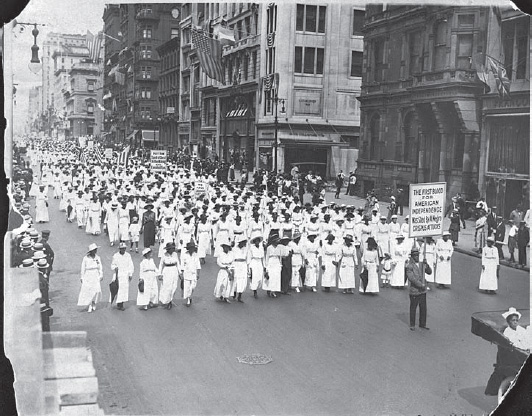
Silent protest parade in New York City against the East St. Louis riots, 1917; sign held in front reads, “The first blood for American Independence was shed by a Negro Crispus Attucks” (digital ID# cph-3a34294, Library of Congress)
On July 28, ten thousand African Americans marched down Fifth Avenue in the Silent Parade. The only sounds emitted were from the muffled drum line that led the parade. Men were dressed in black suits with white shirts and black hats. Women and children wore white. Some of their placards read:
MOTHER, DO LYNCHERS GO TO HEAVEN?
MR. PRESIDENT, WHY NOT MAKE AMERICA SAFE FOR DEMOCRACY?
YOUR HANDS ARE FULL OF BLOOD.
The last one was directed at President Wilson—or perhaps the entire nation. The quiet, peaceful march operated, in part, as a funeral for the victims of lynching and a show of strength and dignity in the face of racial violence. It was a call for action that generated media attention, and an action that highlighted the failure of the federal and state government to protect all of its citizens.
Another prominent visual tactic, presumably initiated by Du Bois, was the unfurling of a black flag that read A MAN WAS LYNCHED YESTERDAY outside the NAACP offices’ window on Fifth Avenue.
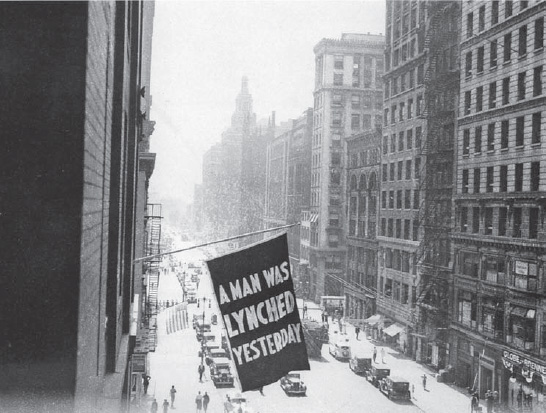
“Flag, announcing lynching, flown from the window of the NAACP headquarters on 69 Fifth Ave., New York City,” ca. 1936 (LC-USZ62-110591, Library of Congress)
This stark message echoed the content of The Crisis and was meant to inspire the New York public to pay close attention to continued violence across the land.
Du Bois also led the 1915 boycott campaign against D.W. Griffith’s film The Birth of a Nation—based on Thomas Dixon’s 1905 bestselling novel The Clansman, which depicted the period of Reconstruction as an era of misrule by rapacious African American politicians, and the sanctity of white women as being threatened by black rapists. The protagonists of the film were the Ku Klux Klan, who were depicted as protecting white women, and by extension, the nation.25 President Wilson had endorsed Dixon’s book and had the film screened in the East Wing of the White House, which he described as “writing history with lightning,” adding that it was “all so terribly true.”26
The deplorable film had deadly consequences. A white patron in Lafayette, Indiana, shot and killed a teenage African American boy after seeing it, and crowds in Houston were reported to have yelled “Lynch him!” at the screen during the scene when the white actor in blackface was attempting to rape a white woman.27 Du Bois called for the entire second half of film to be cut (which the Board of Censors refused to do) and led large demonstrations outside New York theaters. In New York, protesters tossed eggs at the movie screens, and they succeeded in banning the film temporarily in Chicago. Massachusetts went the furthest and completely banned the film in Boston, a move that forced President Wilson to retract his initial enthusiasm. Despite the boycott movement, The Birth of a Nation remained immensely popular.
The Positive Image
“We want everything that is said about us to tell of the best and highest and noblest in us.”
—W. E. B. Du Bois, “Opinion,” The Crisis, June 1921
Du Bois understood that a key way to undermine racism was through culture. His editorial stance of presenting the “talented tenth” in the pages of The Crisis was a direct response to the racist manner in which African Americans were portrayed in mainstream culture. Even the radical press, in particular The Masses, presented African Americans as the “exotic other.” Du Bois wrote, “White Americans are willing to read about Negros, but they prefer to read about Negros who are fools, clowns, prostitutes, or in any rate, in despair and contemplating suicide.”28
The Crisis was designed to challenge this bias. Du Bois filled numerous issues with photographic images of the black middle class—from college graduates to star athletes to those who had achieved success in business, the sciences, and other careers. He intentionally turned a blind eye to examples of unlawfulness, decadence, despair, and self-destruction within the black community. He refused the request by then chairman of the NAACP, Oswald Villard, to include a list of crimes committed by African Americans in The Crisis to counterbalance the list of white crimes. Instead, Du Bois’s emphasis promoted African Americans at their best.
Du Bois had been a master at using photographic images for political purposes long before he became editor of The Crisis. In 1900 he won a gold medal at the Paris Exposition for an exhibition he curated titled Exposition des Nègres d’Amerique [Exhibit of the American Negro]. He displayed photographs of ordinary African Americans, which countered the barrage of racist images that dominated the mass media and popular culture.29 Du Bois, always the historian and sociologist, included charts, maps, and data on black life in the United States. In short, he curated an exhibition to refute racial stereotypes, and this was the driving force behind much of his later work in the pages of The Crisis.
As editor he focused on black subject matter and invited African American artists and authors to contribute their talents to the magazine. During the 1920s—at the peak of the Harlem Renaissance—he became one of the most important patrons of African American art and literature. He routinely highlighted the artwork of Aaron Douglas, Laura Wheeler, Albert Smith, and Hale Woodruff, among others, and published writings by Langston Hughes, Gwendolyn Bennett, Alain Locke, Arna Bontemps, Countee Cullen, Claude McKay, and E. Franklin Frazier. Yet Du Bois’s editorial bias guided what he deemed acceptable. He encouraged artists to depict the “talented tenth” and to look to Africa for inspiration and subject matter. He wrote, “In The Crisis at least, you do not have to confine your writings to the portrayal of beggars, scoundrels and prostitutes; you can write about ordinary decent colored people if you want.”30
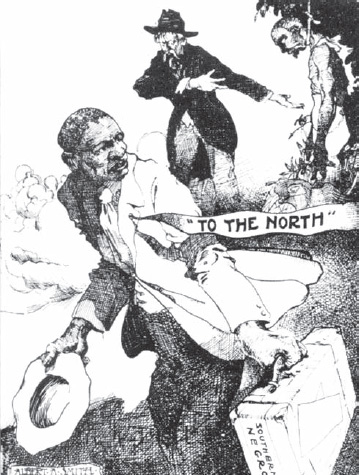
Albert A. Smith, ‘The Reason,” The Crisis, February 1920 (University of Wisconsin–Milwaukee Libraries)
Du Bois expressed a bias for a political art. In a famous speech, “Criteria of Negro Art,” delivered in Chicago in 1926 (and reprinted in The Crisis in the October issue), he stated:
Thus all art is propaganda and ever must be, despite the wailing of the purists. I stand in utter shamelessness and say that whatever talent I have for writing has been used always for propaganda for gaining the right of black folk to love and enjoy. I do not care a damn for any art that is not used for propaganda. But I do care when propaganda is confined to one side while the other is stripped and silent.31
The problem was that many black artists did not want any type of criteria for art, and they did not want Du Bois to dictate what subject matter was appropriate. Instead, they wanted to freely express themselves and all aspects of black life—the good and the bad. Langston Hughes wrote:
We younger Negro artists who create now intend to express our individual dark-skinned selves without fear or shame. If white people are pleased, we are glad. If they are not, it doesn’t matter. We know we are beautiful. And ugly too. . . . If colored people are pleased we are glad. If they are not, their displeasure doesn’t matter either. We build our temples for tomorrow, strong as we know how, and we stand on top of the mountain, free within our-selves.32
Other responses to Du Bois were less diplomatic. Claude McKay angrily wrote, “I should not be surprised when you mistake the art of life for nonsense and try to pass off propaganda as life in art!”33 Du Bois, however, remained rigid. He felt that any negative portrayal of African Americans would empower white America to continue to view them as inferior, and furthermore, it would not uplift the race.34
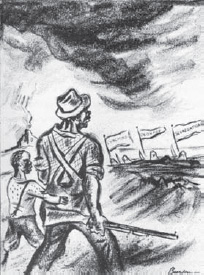
Romare Bearden, “For the Children!” The Crisis, October 1934 (University of Wisconsin–Milwaukee Libraries) (courtesy of VAGA)
In the context of lynch mobs and segregation Du Bois believed that the immediate climate was far too dangerous for artists not to focus full attention on propaganda that would aid the black freedom movement.
“To Du Bois, a literature which did not exist for a moral purpose was a decadent, socially dangerous activity,” wrote Abby Arthur Johnson and Ronald Baberry Johnson.35 Throughout his long tenure as editor he championed an activist agenda. He balanced sharp critiques of injustices with celebratory articles and images of the “best and the brightest”—an approach that drew an equal amount of praise and criticism from his peers.
![]()
On July 1, 1934, Du Bois resigned from the NAACP. He was tired of being censored by the Board of Directors, and they were tired of his editorial control over The Crisis, along with his drift toward radical Marxism and praise for the Soviet Union. Nevertheless, his influence and ideas carried over to subsequent issues of The Crisis. One of the young artists whom he championed—Romare Bearden—published the illustration “For the Children!” in the October 1934 issue, just months after Du Bois had resigned.
It depicted an African American man standing next to his son, holding a shotgun. In the distance are three KKK members, marked by the words lynching, peonage, and segregation. The defiant image—a call for armed self-defense and a precursor to the actions of Robert F. Williams (author of Negroes with Guns) and later the Black Panther Party—was featured in a special issue dedicated to children. Du Bois’s words echoed in Bearden’s image—specifically his September 1919 editorial that read, in part, “When the murderer comes, he shall no longer strike us in the back. When the armed lynchers gather, we too must gather armed. When the mob moves, we propose to meet it with bricks and clubs and guns.”36 Du Bois ended his twenty-four-year reign at The Crisis as the NAACP’s most prominent voice, a scholar and an activist, and a guiding voice to many, including the next generation. There was never a social-justice crusader quite like him, a leader who embraced the arts and a leader who, himself, was an artist.